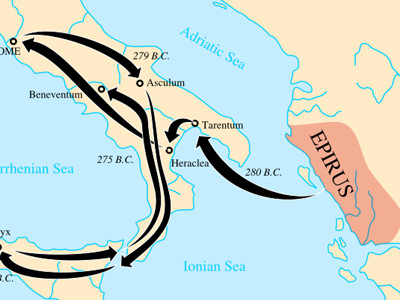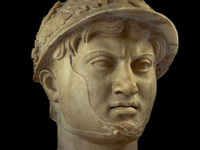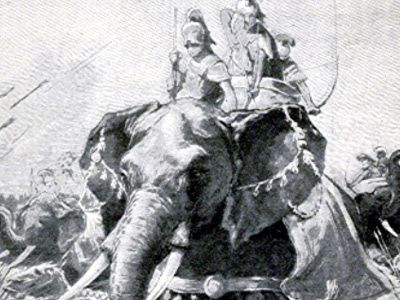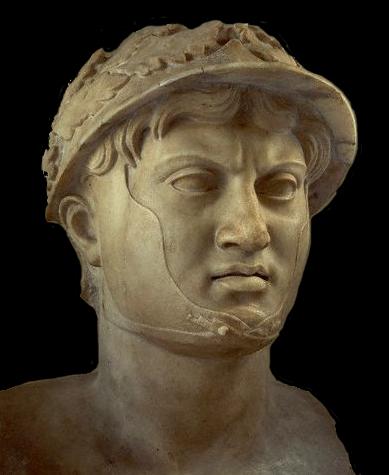Pyrrhic War (280–275 BC)

Sicilian Campaign (278-75 BC)
Pyrrhus went to Sicily and took the leadership of the Greek cities of eastern and southern Sicily in a war against the Carthaginians in western Sicily. There had been a history of conflict between the Greeks and the Carthaginians in Sicily. We have details about Pyrrhus' campaign against the Carthaginians from two fragments from the work of Diodorus Siculus. Plutarch gave only a very brief account, most of which was about the relationship between Pyrrhus and the Greek cities in Sicily. The fragments from the text of Dionysius of Halicarnassus are also about Pyrrhus and the Sicilian Greeks. The fragments from Appian deal mostly with events which occurred when Pyrrhus was leaving Sicily. We have minimal information from the fragments from the text of Cassius Dio.
In Plutarch's account, Pyrrhus received two requests for help. Men from the Greek cities of Sicily "offered to put into his hands the cities of Agrigentum, Syracuse, and Leontini, and begged him to help them to drive out the Carthaginians and rid the island of its tyrants." The Macedonians asked him to accede to the throne of Macedon when their king, Ptolemy Keraunos, whose army was defeated in the Gallic invasion of Greece, was captured and beheaded by the Gauls. Pyrrhus decided that Sicily provided better opportunities for glory since Africa "was felt to be nearer" - Plutarch thought that Pyrrhus coveted the conquest of Carthage, which was in Africa. He sent Cineas to hold talks with the Greek cities in Sicily while he garrisoned Tarentum. The Tarentines were unhappy and demanded that he either continue the war with Rome or go away and leave Tarentum as he had found it. In other words, they wanted the end of his tyrannical rule of the city if he left. Pyrrhus left without giving a reply.
Appian wrote that Pyrrhus begun to be more concerned about Sicily than Italy because Agathocles, the tyrant of Syracuse and self-proclaimed king of Sicily, had just died and he had married his daughter Lanassa. However, Appian must have been confused. Agathocles died in 289 BC, nine years before Pyrrhus’ venture in Italy and eleven years before he went to Sicily. Moreover, Lanassa had left Pyrrhus in 291 BC. According to Appian, Pyrrhus was reluctant to leave those in Italy who had asked for his help without a peace settlement. He sent Cineas to Rome to negotiate a peace once more. He received the same answer. The Romans The Roman Republic was a form of government of Rome and the era of the classical Roman civilization when it was run through public representation of the Roman people. Beginning with the overthrow of the Roman Kingdom (traditionally dated to 509 BC) and ending in 27 BC with the establishment of the Roman Empire, Rome's control rapidly expanded during this period - from the city's immediate surroundings to hegemony over the entire Mediterranean world. returned the Tarentines and the Italic allies they held as prisoners. In Appian's account there was an armistice. Pyrrhus then set off for Sicily with 8,000 cavalry and his elephants. He promised his allies that he would return to Italy. Pyrrhus left Milo in Tarentum to garrison the city. According to Justin, he also left his son Alexander to garrison Locris.
The Roman Republic was a form of government of Rome and the era of the classical Roman civilization when it was run through public representation of the Roman people. Beginning with the overthrow of the Roman Kingdom (traditionally dated to 509 BC) and ending in 27 BC with the establishment of the Roman Empire, Rome's control rapidly expanded during this period - from the city's immediate surroundings to hegemony over the entire Mediterranean world. returned the Tarentines and the Italic allies they held as prisoners. In Appian's account there was an armistice. Pyrrhus then set off for Sicily with 8,000 cavalry and his elephants. He promised his allies that he would return to Italy. Pyrrhus left Milo in Tarentum to garrison the city. According to Justin, he also left his son Alexander to garrison Locris.
Plutarch wrote that Thoenon and Sosistratus, the leading men in Syracuse, were the first to persuade Pyrrhus to go to Sicily. Diodorus Siculus wrote that "Thoenon controlled the island [of Syracuse], while Sosistratus ruled Syracuse. They had ten thousand soldiers [in Syracuse], and carried on war with each other. But both, becoming exhausted in the war, sent ambassadors to Pyrrhus." While Pyrrhus was preparing to set sail, the Carthaginians were besieging Syracuse. They blockaded her port with a fleet. They conducted operations near the city walls and pillaged the countryside with 50,000 men. The Syracusans pinned their hopes on Pyrrhus because he had married Lanassa. When Pyrrhus set sail from Tarentum, he stopped over at Locris.
The Mamertine mercenaries who had seized the city of Messana (Messina) made an alliance with the Carthaginians and joined them in trying to prevent Pyrrhus from crossing the Strait of Messina. Therefore, Pyrrhus could not land at Messana or Syracuse. However, Tyndarion, the tyrant of Tauromenia (Taormina, south of Messana), sided with Pyrrhus and was willing to receive his forces in his city. Pyrrhus received soldiers from him and then landed at Catana, which was also between Messana and Syracuse. He was welcomed by its citizens and disembarked his infantry, which marched on Syracuse, flanked by the fleet. When he got close to Syracuse, a reduced Carthaginian fleet (thirty ships had gone on other missions) left.
Pyrrhus accepted delivery of the "[i]sland [of the city] from Thoenon, and of the rest of the city from the citizens and Sosistratus." He added that, besides ruling Syracuse, "Sosistratus had made himself master of Agrigentum and of many other cities, and had an army of more than ten thousand men." Pyrrhus reconciled "Thoenon and Sosistratus and the Syracusans and restored harmony, thinking to gain great popularity by virtue of the peace." He took over the military equipment of the city and her 140 ships. Pyrrhus now had more than 200 ships. Dionysius of Halicarnassus wrote that Sosistratus was the ruler of the city and Thoenon was the commander of the garrison. They gave Pyrrhus money from the treasury and 200 warships. According to Diodorus Siculus, the ruler of the city of Leontini handed him over the city and its 4,000 infantry and 500 cavalry. Other cities did the same. The city of Enna had expelled the garrison the Carthaginians had placed there, and promised to hand itself over to Pyrrhus. Pyrrhus went to Agrigentum and took over the city, as well as 8,000 infantry and 800 cavalry who were picked men. He also took over thirty cities ruled by Sosistratus and brought over the siege engines and the missiles of Syracuse.
According to Diodorus Siculus, Pyrrhus set off for the territories subject to the Carthaginians with 30,000 infantry and 1,500 cavalry. In Plutarch's account Pyrrhus had 30,000 infantry, 2,500 cavalry and 200 ships. Diodorus related that Pyrrhus defeated the Carthaginian garrison in Heraclea Minoa and seized Azones. Selinus, Halicyae, Segesta and other cities went over to him. He besieged Eryx, which had strong natural defensive features and a large Carthaginian garrison. The siege lasted a long time, but Pyrrhus managed to take the city by storm. He left a garrison there and attacked Iaetia, which was a powerful city in a good strategic position to attack Panormus, which had the best harbour in Sicily. Iaetia surrendered without a fight. Panormus was taken by storm. Pyrrhus was in control of all the Carthaginian dominions except for Lilybaeum. While he was besieging this city, the Carthaginians brought over a big army and large quantities of grain from Africa. They also strengthened the fortifications of the city. Plutarch, whose account of Pyrrhus’ campaign in the Carthaginian territories was brief, just wrote that that Pyrrhus subdued the areas under Carthaginian control and that after seizing Eryx he moved against the Mamertine mercenaries who had seized Messana. They were a nuisance to the Greeks and even imposed a tribute on some of them. Pyrrhus captured their tribute collectors and executed them. He defeated the Mamertines in battle and destroyed many of their strongholds. Plutarch did not mention the siege of Lilybaeum and Diodorus Siculus did not mention the campaign against the Mamertines.
Both Plutarch and Diodorus Siculus wrote that the Carthaginians initiated negotiations. They offered a large sum of money. In Plutarch's account, they also offered ships. According to Diodorus Siculus, Pyrrhus refused to accept money and was persuaded to concede Lilybaeum to the Carthaginians. However, his friends and the delegates from the Greek cities urged him not to "grant [them] a stepping-stone for an attack on Sicily, but rather to drive the Phoenicians out of the entire island and to make the sea the boundary of his domain." Plutarch did not mention Pyrrhus being swayed by his friends and the delegates of the cities. In his version, Pyrrhus rejected the offer because he wanted "to pursue the ambitions for which he had left home in the beginning and set his heart on Libya." In other words, Pyrrhus wanted to conquer Carthage, which was in what the Greeks called Libya (Plutarch was Greek) and the Romans called Africa. In Diodorus Siculus’ account, the negotiations occurred during the siege of Lilybaeum. After this Pyrrhus engaged in skirmishes near the city walls. The Carthaginians resisted effectively because of the size of their forces and because they had so many catapults that there was not enough room for all of them on the city walls. Many of the men of Pyrrhus were killed and he was at a disadvantage. Pyrrhus set out to build war engines which were more powerful than those he brought from Syracuse. However, the Carthaginian resistance continued, favoured by the rocky terrain. After two months he gave up the siege. Pyrrhus then bent his efforts towards building a large fleet to transport his troops to Africa after he gained mastery of the sea.
Plutarch wrote that many of Pyrrhus' ships were undermanned and he begun to collect oarsmen. He stopped dealing with the Greek cities fairly and treated them in a despotic manner, using compulsion and imposing fines. He was no longer a popular leader. He became a tyrant known for "ingratitude and faithlessness". At first the Sicilian Greeks put up with this. Things changed when Pyrrhus became suspicious of Sosistratus and Thoenon, the men who had invited him to Sicily and had been of great assistance to him. Sosistratus was afraid of the suspicions of Pyrrhus and keep a low profile. Pyrrhus accused Thoenon of complicity with Sosistratus and had him executed. Dionysius of Halicarnassus gave some details of the behaviour of Pyrrhus. He seized the estates of Agathocles of Syracuse from the relatives and friends who had inherited them and gave them to his friends. He gave the chief offices in the cities to his military men. He conducted some trials and some administrative tasks himself and assigned others to members of his court, who were interested only in personal gain and luxury. He established garrisons with the excuse that they were for protection against the Carthaginians. He arrested the cities’ most prominent men and had them executed on false treason charges, one of whom was Thoenon. Pyrrhus tried to arrest Sosistratus, but he escaped from the city.
The actions of the king caused hatred in the Greek cities. According to Plutarch, some of them sided with the Carthaginians and some called in the Mamertine mercenaries. While Pyrrhus was facing opposition and rebellion, he received a letter from the Tarentines and Samnites. The Samnites had been pushed out from their rural areas and found it difficult to defend their cities and begged him to come to their assistance. This gave Pyrrhus an excuse to leave Sicily, where he had lost control, without appearing to be running away. Plutarch wrote that Pyrrhus said "My friends, what a wrestling ground for Carthaginians and Romans we are leaving behind us!" We do not know whether Pyrrhus actually said this because ancient historians often made speeches by historical characters up. Cassius Dio wrote what when the Carthaginians saw that Pyrrhus' forces were small and that he had lost the goodwill of the Sicilian Greeks, they "took up the war vigorously. They harboured the Syracusans who were exiled and harassed [Pyrrhus] so severely that he abandoned not only Syracuse but Sicily as well." Dionysius of Halicarnassus that wrote the Carthaginians sent an army to Sicily because the situation gave them an opportunity to regain the cities they had lost. After Pyrrhus left Sicily, the Carthaginians took control of their domains in the west again.
HISTORY

RESOURCES
This article uses material from the Wikipedia article "Pyrrhic War", which is released under the Creative Commons Attribution-Share-Alike License 3.0.
© Stories Preschool. All Rights Reserved.










